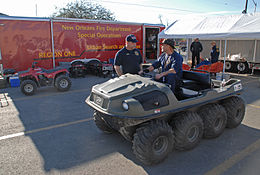
Back ATV-amfibi Catalan ATV-anfibio Spanish Ամենագնաց Armenian Жол тандабас Kirghiz Вездеход Russian Худрави ҳамаҷогард Tajik Вездеход TYV Всюдихід Ukrainian Vezdexod Uzbek
This article needs additional citations for verification. (November 2012) |


An amphibious all-terrain vehicle, or amphibious ATV (or AATV), is a small, all-wheel drive, all-terrain amphibious vehicle, used for recreation, farm-, hunting, utility or industry tasks, by enthusiasts and professionals worldwide. They are legally off-highway vehicles in many countries, or at least restricted from use on express highways and motorways – their use is generally extra-urban.
Amphibious ATVs frequently use a lightweight body-tub with wide balloon tires and a simple drivetrain without any wheel suspension or steering – the only cushioning is provided by the soft tires, that also contribute to floatation in the water. Steering is through differential steering, also known as skid-steering. Models are frequently six-wheel drive, or eight-wheel drive on larger models.
They were marketed from the early 1960s and quickly became popular, predominantly for recreation, in both the United States and Canada, originally called all-terrain vehicle (ATV).[1] However, after the introduction of cheaper small three- and four-wheeled off-road motorcycles in the 1970s and 1980s, these became more popular, and the nomenclature 'ATV' shifted in usage to refer to the latter non-amphibious, straddled little off-road motorbikes.
To distinguish the original class of vehicles from the newer, straddled ATVs, the amphibious ones now go by the classification of 'amphibious ATV'.
- ^ "About this Site". www.route6x6.com.